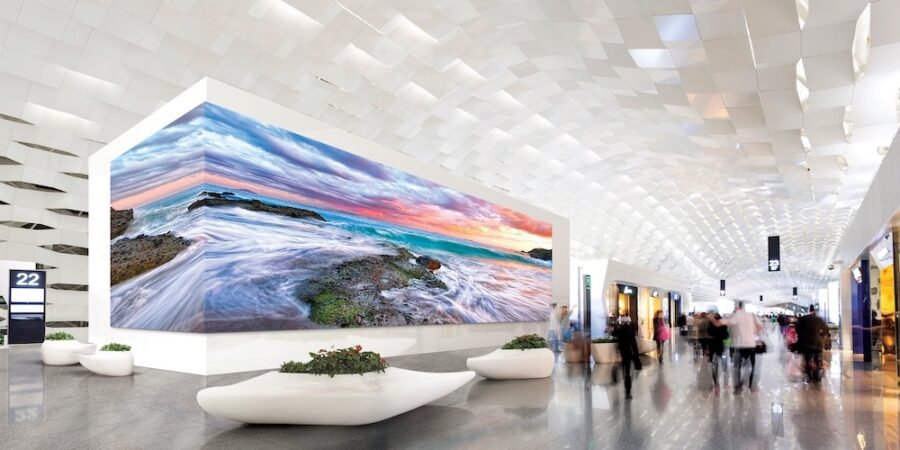In a noisy marketplace, it pays to stand out. That’s why LED displays are becoming a go-to communication medium for brands striving to cut through the clutter and capture consumer attention. Dynamic, vivid, high-quality digital signage is far more compelling than its static counterparts. And when you can command attention, profit is not far off.
The key to capturing that attention? Resolution. Crisp and vivid content catches the eye, communicates clearly and instills trust. Blurry, low-quality imagery does the opposite.
If you’re not an audiovisual (AV) pro, LED display resolution may be a difficult concept to grasp. Most of us can appreciate the detail and beauty of high-resolution content we consume on our mobile devices and TVs. But how should a business owner or brand manager go about selecting a resolution for commercial pursuits?
To simplify things, here’s a breakdown of exactly what resolution is and the factors impacting its effectiveness — plus a few examples of how it works in real life. In the end, you’ll have a better sense for which resolution you’ll need for your next project.
What is resolution?
It all comes down to pixels. Generally speaking, resolution is a measurement of how many pixels are packed into a given display area. Resolution is typically denoted in a width x height format. You might be familiar with some of these common resolutions:
Pixels are the building blocks of digital images; they combine to form images like bricks combine to form a wall. And the more pixels you have in a given space, the higher fidelity those images can be.

Resolution and pixel pitch
Here’s where things get a bit trickier. Resolution is not only a function of how many pixels are housed in a given display space, but also how densely those pixels are packed together. This brings us to pixel pitch, which is the distance between each pixel.
Typically measured in millimeters (16mm on the high end, 0.5mm on the low end), the lower the pixel pitch, the more tightly packed the pixels — and the crisper the image. As you might imagine, the higher the pixel pitch, the bigger the display needs to be in order to reach a target resolution. In fact, it’s the combination of pixel pitch and the size of the display that determines the resolution itself.
The higher the pixel pitch, the greater the cost. That’s because as pixel pitch increases, so too does the number of LEDs that need to be mounted on a given display module. A significant part of the cost of building a display is in the manufacturing of these modules.
Which resolution is right for you?
For use cases where your viewer will be up close to a display — environments like lobby walls, conference rooms and restaurants — you’ll need higher resolution to deliver a crisp, clear picture, even when they’re standing right in front of your display. The good news is, in these instances, you can use a much smaller display than you’d need in an outdoor environment.
On the other hand, for outdoor applications like a highway billboard, you won’t necessarily need the pixels to be as dense — because you’re operating with a larger viewing distance. According to the experts at Samsung, a good rule of thumb for considering pitch and viewing distance is that 1mm in pitch equals 8 feet of viewing distance.
Three types of resolution — and their use cases
Now that we’ve covered the nuts and bolts of resolution, let’s take a look at the three main categories of resolution use cases — and a real example from each.
Communication display
At about 48 to 60 pixels tall, you’ve got enough resolution to display a text-based message to your audience. Whether that’s “Free Oil Change” or “25 percent off, today only,” words are usually all you need to captivate passersby and get them to take action.
Graphic display
Moving up to 61 to 100 pixels tall puts you in a new category — one where displaying visual imagery becomes possible. Icons, logos, 3D text and basic graphic representations of the products and services you’re promoting are all fair game.
Video display
Once you’re above 100 pixels tall, you’re in high-resolution video display territory. The content you can display here is more akin to what you’d see on your favorite streaming service. You can show video or premium images that look vivid and appealing.
How to plan and deploy direct view LED signage
Everything you need to know about choosing your LED displays for optimal viewing indoors and out. Download Now
Finding the resolution sweet spot
Determining the best resolution for your LED display is about balancing all the factors covered in this guide, from use case to application to viewing distance. While this information should help you get a better understanding of this tricky concept, your best bet is to work with a seasoned AV pro who knows LED displays inside and out and can guide you to the perfect solution for your project and budget.
Want help identifying the best, most cost-effective LED display for your next project? Get in touch with the experts at Samsung today.
For more help getting started on your display project, find everything you need to know about choosing your LED displays for optimal viewing indoors and out in this free comprehensive guide. And for the top-of-the-line resolution, discover Samung’s lineup of 8K displays — designed to deliver unparalleled visual quality wherever you need it.








